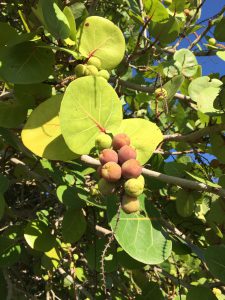Sea grapes: succulent and strong
The sea grape (Coccoloba uvifera) is a native beach and fore dune plant species. Sea grapes are critical members of coastal communities, particularly on water-facing dunes. Sea grapes require a full sun exposure and sandy, well-drained soils. It is also very salt-tolerant. These requirements make them well-suited for coastal locations. The way that they grow is dependent on local conditions, particularly, wind shear. The sea grapes’ leathery leaves are round and wide and can grow up to eight to ten inches in diameter. The trees themselves can grow upwards of 50 feet! Sea grape berries are edible and are used to make jelly and, in some areas, wine.

Sea grapes trap sand in their leaves, limbs, and stalks, which helps to stabilize beaches and dunes. This stabilization slows erosion and protects inland areas. The berries serve as a food source for native bird and mammal species. In addition to their beauty, sea grapes serve an important role on beaches by blocking artificial lighting from the beach, which aids nesting sea turtles and hatchlings alike.

While not protected by a state or federal listing, the sea grape carries special considerations due to their ecological importance. Sea grapes living in dune habitats may not be altered or damaged, and coastal property owners must obtain permits to alter the sea grapes on their properties. For more information on regulatory requirements of sea grape trimming, please visit: https://floridadep.gov/sites/default/files/trim-gdl.pdf
The next time that you are walking on the beach, take a moment to admire these cool plants, or consider adding them into your home landscape. They flourish inland, too!
 3
3
